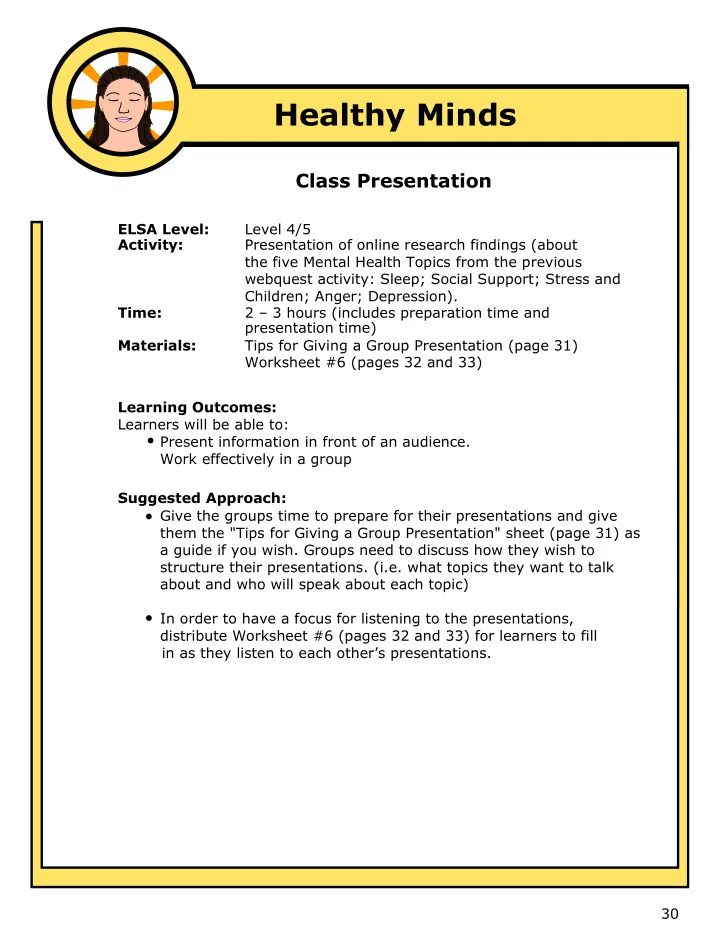

Healthy Minds Healthy Minds Class Presentation ELSA Level: Level 4/5 Activity: Presentation of online research findings (about the five Mental Health Topics from the previous webquest activity: Sleep; Social Support; Stress and Children; Anger; Depression). Time: 2 – 3 hours (includes preparation time and presentation time) Materials: Tips for Giving a Group Presentation (page 31) Worksheet #6 (pages 32 and 33) Learning Outcomes: Learners will be able to: Present information in front of an audience. Work effectively in a group Suggested Approach: Give the groups time to prepare for their presentations and give them the "Tips for Giving a Group Presentation" sheet (page 31) as a guide if you wish. Groups need to discuss how they wish to structure their presentations. (i.e. what topics they want to talk about and who will speak about each topic) In order to have a focus for listening to the presentations, distribute Worksheet #6 (pages 32 and 33) for learners to fill in as they listen to each other’s presentations. 30
Tips for Giving a Group Presentation Divide the work evenly among your group members. Divide your topic into sub-topics for each person to talk about. For example, if your topic is “Learning English” some sub-topics might be: Reasons for Learning English Techniques for Learning English Difficulties in Learning English Introduction: A good presentation has an introduction. The introduction should catch your audience’s attention. You can try asking the audience a question, give them an interesting statistic, or tell an anecdote to introduce your topic. You should also introduce the group members at the beginning of the presentation. Hand-offs: A “hand-off” means passing the presentation from one group member to the next. To make the hand-off smooth, you should introduce the next speaker and what sub-topic they will talk about: “Now Lee will speak to you about Techniques for Learning English”. Conclusion: A good presentation has a conclusion. That does not mean simply saying “OK. We’re finished.” You need to find a way to finish the presentation by summarizing what was talked about, giving an opinion, making a suggestion, or making a prediction for the future. Ask your audience if they have any questions and finally, don’t forget to thank your audience for their time and attention: “Thank you very much for listening.” “Thank you very much for your attention.” 31
Worksheet # 6 Listen to the presentations and fill in the information – Presentation #1 – Sleep How much sleep do people need? What are some different kinds of sleep problems? How do sleep problems affect our mental health? What are some tips for getting a good night’s sleep? Why are there more stress related sleep disorders now? Presentation #2 – Social Support What does “social support” mean? What are some different kinds of social support? Why is social support important? How can you develop a social support system? What is the relationship between social support and mental illness? Presentation #3 – Stress and Children What are some signs that a child is experiencing stress? When and why do children feel stress? How can you help your children to manage stress? 32
Presentation #4 – Anger Why is too much anger bad for us? When is anger a problem? What kind of problems can anger cause in your life? When a person gets angry, what kind of physical changes happen in the body? Why are some people more angry than others? What are some strategies to control anger? Presentation #5 – Depression What are some symptoms of depression? What are some treatments for depression? What are some misconceptions about depression? (a misconception is something that many people think is true, but, in fact is not true) What are some statistics about depression in Canada? What is “seasonal affective disorder” (S.A.D.) and how can you treat it? 33
Recommend
More recommend